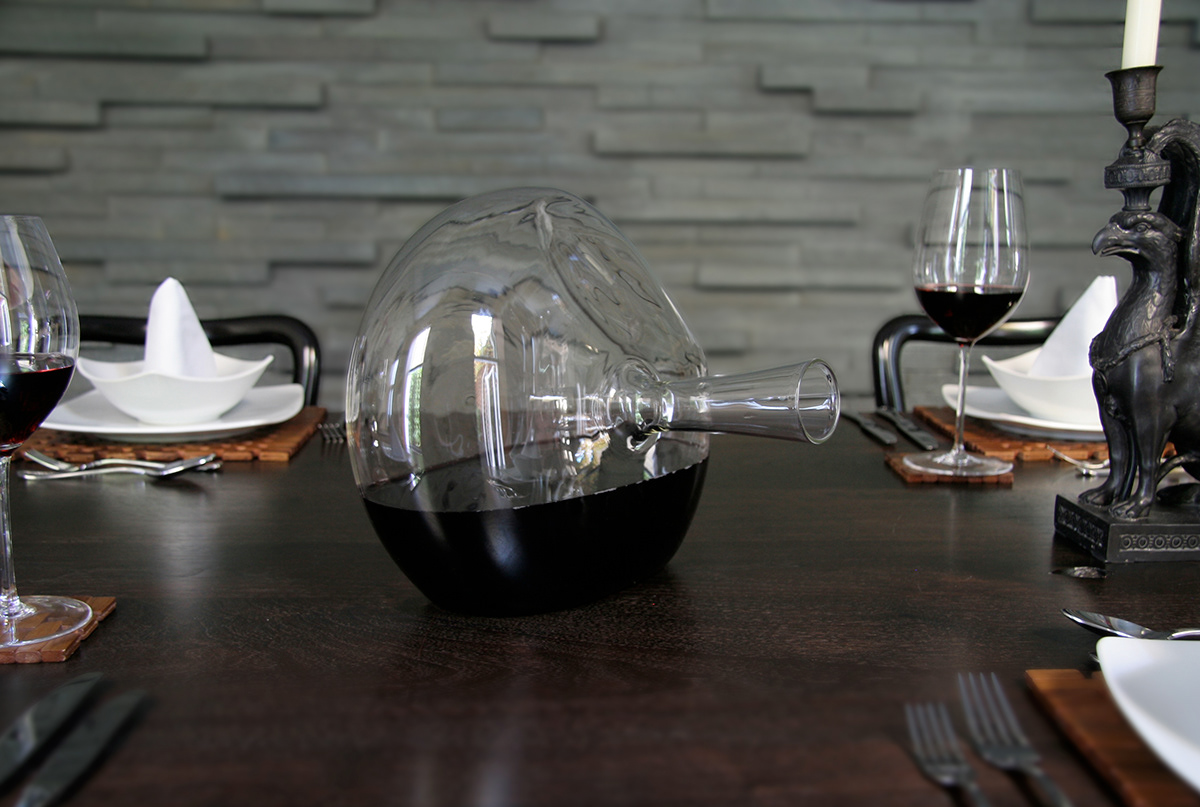




Borosilicate Glass. Reddot design award winner 2012
Mouth-blown and formed by hand in England, without the use of moulds. Due to the extensive work required to make each piece, these luxury decanters are only produced in limited runs of 20, no more than four times per year. Each piece is accompanied by a certificate, indicating its unique production number.
Why 13° 60° 104°? The three possible angles at which the decanter can sit.
At 13 degrees, the decanter begins the evening sober. As drinking progresses, at 60 degrees the decanter is a little tipsy. By the end of the evening, it sits at a drunken 104 degrees.
At 13 degrees, the decanter begins the evening sober. As drinking progresses, at 60 degrees the decanter is a little tipsy. By the end of the evening, it sits at a drunken 104 degrees.
Wine evolves with age – constantly changing, gaining complexity. But its full range is rarely experienced.
Wine changes most once the cork is out, once air touches the liquid. The flavour transforms. But all too often the bottle is empty before the wine reaches its peak, because the rate at which the wine is drunk is greater than that of the transforming flavours.
Wine changes most once the cork is out, once air touches the liquid. The flavour transforms. But all too often the bottle is empty before the wine reaches its peak, because the rate at which the wine is drunk is greater than that of the transforming flavours.
The 13° 60° 104° encourages oxygen into the wine with every turn as the liquid moves and the wine's potential flavours can emerge.
The man behind the Saltoun Supper Club Arno Maasdorp, appreciates the three concave bases. They remind him of the deep punts at the bottom of an expensive bottle of wine. Arno knows that the correct way to hold a bottle of wine is by the bowl (not the neck). He finds that he can hold the large bowled 13° 60° 104° decanter in this way - the thumb sits inside the punt.
Arno suggested small adjustments to the scale and now the three angles represent standard wine measures.
13° 60° 104° Magnum, 200mm: The upright position measures a magnum, the middle position holds a single bottle of wine and in the downward position, it needs a refill.
13° 60° 104° 0.75 litre, 170mm: The upright position measures a standard bottle, the middle position holds a Demi ('half' in French) and the decanter in the downward position needs a refill.
13° 60° 104° Magnum, 200mm: The upright position measures a magnum, the middle position holds a single bottle of wine and in the downward position, it needs a refill.
13° 60° 104° 0.75 litre, 170mm: The upright position measures a standard bottle, the middle position holds a Demi ('half' in French) and the decanter in the downward position needs a refill.
“That’s very good”, offers the understated designer. “It’s bloody genius, that’s what it is”, corrects Arno.
Sometimes when decanting an expensive bottle of wine, sediment can enter the decanter. In this case the decanter’s back and forth pouring movement can be minimised so that the sediment is not disturbed.
"Decanting is so important to let wine breathe. We have never seen such a practical yet creative solution to wine presentation and decanting."
Daniel Primack, Winerackd, London.
Daniel Primack, Winerackd, London.
"A genuinely pioneering product. This has, rather amusingly, turned decanting design on its head – or, to be precise, its side... Moreover, moving the decanter into each position increases the wine’s exposure to oxygen, thereby bringing out the flavours and aromas at a faster rate."
John Stimpfig, contributing editor at the Financial Times’ 'How to Spend It' & editorial content director of Decanter Magazine.
John Stimpfig, contributing editor at the Financial Times’ 'How to Spend It' & editorial content director of Decanter Magazine.
Featured in Nowness, The Sunday Times Style Magazine,Damn magazine and the Independent.
OHIM Design Registration number: 002148510-0001
USA Design Patent application number: 29/475,238
China Design Patent number: ZL 2013 3 0120618.8
Hong Kong Design Registration Number: 1200863.3
USA Design Patent application number: 29/475,238
China Design Patent number: ZL 2013 3 0120618.8
Hong Kong Design Registration Number: 1200863.3
White wine decanters - photographed by John R Ward. Art direction by Arno Maasdorp.

